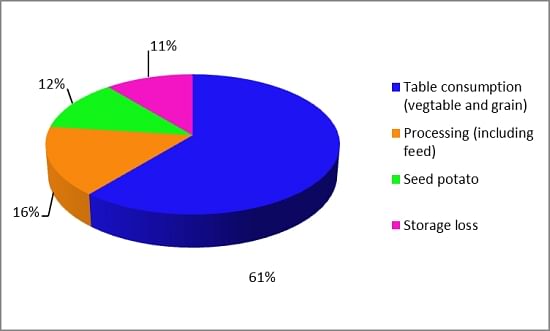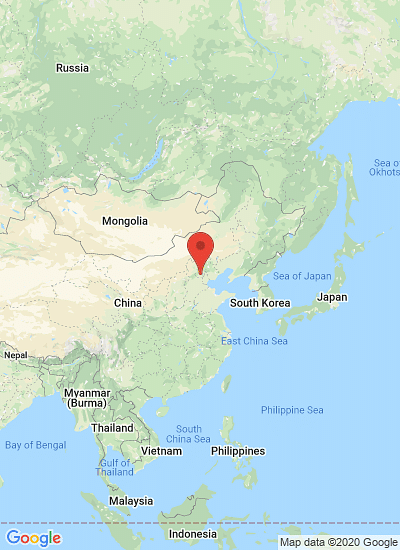China's import of Frozen French Fries by marketing year (MY) in Metric Tonnes, total import (World) and import from the United States (Courtesy: GAIN/ Global Trade Atlas)
Potatoes and Potato Products in China 2015 (GAIN report)

USDA Foreign Agricultural Service regularly reports on various agricultural topics around the world. In GAIN report CH15036 published in September 2015, the production of potatoes and potato products in China as well as imports and exports are highlighted.
China's Policy to boost potato production
In January 2015 China's Ministry of Agriculture (MOA) announced that China was boosting its potato production and consumption to transform the crop into the country's fourth major “grain: after rice, wheat and corn. The Ministry of Agriculture is planning to expand potato acreage to 150 million mu (10 million hectares) by 2020 from the current 80 million mu (5.3 million hectares) without using land currently utilized for rice, wheat and corn production.
However, many obstacles remain to achieve these ambitious goals. For example the potato is not yet consumed widely as a food. The government has provided some financial resources for research and development to identify new food uses for the potato to make it more widely utilized in the local diet.
As of date, no major financial commitment from the government has been identified to make this policy a reality.
Also, industry has expressed concern that the lack of the processing potato varieties has been one of the major bottlenecks for China’s potato processing sector. Shepody and Atlantic have been major processing potato varieties for many years, while no new varieties are introduced. However, the government is revising the Seed Law that may result in seed potatoes being excluded from seed registration. This would accelerate potato variety development since it normally takes 3-5 years to complete seed registration in China.
Potato Production in China
China is the largest potato producer in the world despite its relatively low potato yields.
According to Ministry of Agriculture, China’s average potato yield in MY2014/15 was 17MT/ha, about 1/3 of the U.S. yield. Reasons for the low yields are the use of low-quality seed potatoes and incidence of disease. Industry sources note that virus free seed potatoes only account for 20 percent of total seed potato used in China.
Fresh potatoes
Post forecasts China’s fresh potato production for MY2015/16 will reach 98 million metric tons (MMT), a 3 percent increase from the 95 MMT in MY2014/15 due to an expansion of the potato crop area.
China’s potato crop area is estimated at 5.8 million hectares in MY2015/16, about 3 percent increase from the previous year.
Industry sources indicated that potato acreage did not expand as much as expected due to the relatively low potato prices in MY2014/15.
Potato Processing in China
Processing potatoes account for 10-15 percent of total production, and include such products as starch, frozen French fries, chips, and dehydrated potatoes. The production rate for processing potatoes has remained the same for the last several years because of the lack of processing potato varieties and a shortage of modern potato storage facilities.
China's production of potato starch
China’s MY2015/16 potato starch production is forecast at 550,000 MT, a 22 percent increase from 450,000 MT in MY2014/15, based on the aforementioned government efforts to increase potato starch consumption. Industry sources indicate approximately 7-8 tons of fresh potatoes can produce 1 ton of starch.
China’s potato starch production capacity exceeds one million metric tons but inadequate storage facilities, and outdated technology, keep production between 350,000-500,000 metric tons. China’s starch manufactures are also highly fragmented with production split between thousands of producers and only a few firms have production that exceeds over 8,000 MT.
The production of Frozen French Fries in China
China’s MY2015/16 Frozen French Fries production is forecast at 210,000 MT, a 17 percent increase from the estimated 180,000 MT in MY2014/15 because new production capacity is expected to run in the new marketing season. Frozen French Fries production has strict fresh potato requirements, such as shape, starch content, sugar content, and color. Therefore, some processors usually contract with farmers to produce potatoes that can meet certain quality conditions.
Potato Consumption in China
The majority of fresh potatoes are used for direct consumption. No reliable data for potato currently exits. Post believes the structure of China’s potato consumption remains stable.

Potato use in China by category as a percentage of total in 2009-2011 (Source: GAIN Report CH15036 / Vegetable and Flower Research Institute, China Academy of Agricultural Science)
China’s frozen french fry consumption will continue to increase in the coming years. Continued urbanization and resulting increasing number of fast food restaurants, the major market channel for frozen french fry, will underpin consumption growth.
Potato starch is widely used in food products and is also consumed by other industrial sectors such as textile, paper mill, chemical, and pharmaceutical industries. Potato starch consumption fluctuates with price as other starch inputs, such as corn and bean, are easily substituted for potato starch.
China's import of Frozen French Fries
Post forecasts China’s MY2015/16 Frozen French Fries imports at 130,000 MT, similar to the 129,034 MT in MY2014/15. Industry believes Frozen French Fries consumption in China would continue to remain the same with the continued urbanization; however, the increasing market demand would be mostly filled by increasing domestic production while imports would maintain current levels. Frozen French Fries are traded under (HS Code: 20041000)
Although China’s MY2014/15 Frozen French Fries imports from the United States declined to 85,596 MT from the 97,877 MT in MY2013/14, the United States continues to dominate China’s imported Frozen French Fries market, accounting for 66 percent of total imports in MY2014/15. Canada, accounts for 19 percent of total french fry imports.
China's import of Fresh Potatoes
China does not allow market access for fresh potato imports due to Sanitary and Phyto-Sanitary (SPS) concerns.
China's import of Potato Starch
Post forecasts China’s MY2015/16 potato starch (H.S. code: 11081300) imports at 36,000 MT, a 5 percent decrease from 37,947 MT in MY2014/15 due to the domestic production increase.
China's Potato Export
Post forecasts China’s MY2015/16 fresh potato (HS code: 0701) exports at 510,000 metric tons MT, similar to the 497,855 MT in MY2014/15. Malaysia, Vietnam, Russia, and Pakistan are the four largest export markets for China, accounting for 64 percent of China’s total fresh potato exports in MY2013/14.
China's export of Frozen French Fries
China’s MY2015/16 Frozen French Fries exports are forecast at 16,500 MT, a 9 percent decrease from the 18,196 MT exported in MY 2014/15. China’s MY2014/15 Frozen French Fries exports increased 20 percent from MY2013/14 largely as a result of a significant increase to Hong Kong. According to Chinese Customs, China’s MY2014/15 Frozen French Fries exports to Hong Kong amounted to 5,266 MT, 175 percent increase from previous year. Industry sources indicated that the Frozen French Fries exports to Hong Kong were sourced from the United States and re-exported to Hong Kong. According to Hong Kong Customs, Hong Kong 2014/15 Frozen French Fries imports from the United States declined to 15,109 MT from the 26,135 MT in MY2013/14; as comparison, imports from China increased to 5,782 MT from the 843 MT.
Japan continues to be the largest buyer of China’s Frozen French Fries.
Marketing Frozen french Fries
Quick Service Restaurant (QSR) chains have been the largest buyers of frozen potato products in China, along with hotels, restaurants, and bars. Industry sources believe that third-tier cities represent great potential for FFF consumption because after 20 years of rapid expansion, western fast food outlets have saturated first/second-tier cities while consumers in the third-tier have less exposure to fast food outlets but are adopting similar food consumption habits as their peers in more developed cities such as Beijing and Shanghai.
Currently, there is limited home consumption of frozen potato products.








